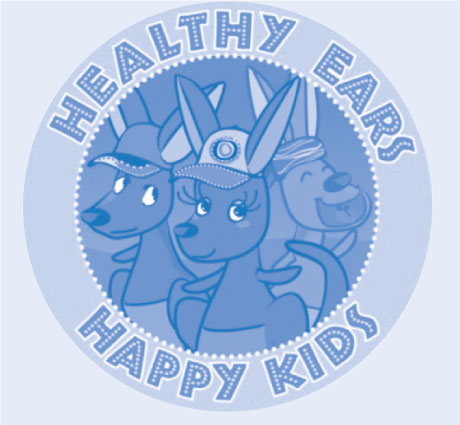Healthy Ears, Happy Kids: a new approach to Aboriginal child ear health in NSW
Paul Huntley A , Brian Woods B and Sian Rudge CA Centre for Aboriginal Health, NSW Ministry of Health
B Mental Health and Drug and Alcohol Office, NSW Ministry of Health
C Sax Institute
NSW Public Health Bulletin 23(4) 60-61 https://doi.org/10.1071/NB12067e
Published: 13 June 2012
Otitis media is one of the most prevalent childhood conditions in developing countries and contributes to excess childhood mortality.1 For children in developed countries, otitis media usually resolves spontaneously and without antibiotic treatment. In developing countries or in communities subject to socio-economic disadvantage, including many Australian Aboriginal communities, acute instances of the condition often do not resolve and may recur repeatedly.2 Children with conductive hearing loss associated with otitis media may experience serious interruption to speech and language development and disrupted learning in school. For other children this can further exacerbate other educational and social disadvantages.1
To address ear health issues for Aboriginal children in NSW under the National Partnership Agreement for Closing the Gap in Indigenous Health Outcomes initiative, NSW Health has developed and released the NSW Aboriginal Ear Health Program Guidelines 2011–2015.
The NSW Otitis Media Screening Program for 0–6 year old Aboriginal children was the NSW Health approach to ear health in Aboriginal children from 2004 to 2008. This program was a population-based (near universal) screening initiative to identify and treat young Aboriginal children with otitis media. The Centre for Aboriginal Health commissioned an evaluation of the effectiveness and appropriateness of this program in 2008. The evaluation involved extensive consultation across the sector through case studies and interviews with frontline health workers and policy makers from Aboriginal Community Controlled Health Services, the Department of Education and Training, the former Department of Health, the Office for Aboriginal and Torres Strait Islander Health, and the former Area Health Services.
The evaluation found that the program did not address the underlying social and environmental factors contributing to ear disease, was unsupported by evidence, was cost prohibitive and did not reduce prevalence.3 It recommended discontinuing the existing approach and adopting a broad public health approach that integrated the ear health program with existing child health surveillance and health-care programs, such as Child Health Checks, the Personal Health Record (Blue Book), the Aboriginal and Maternal Infant Health Strategy, the Aboriginal Oral Health Program, Statewide Eyesight Pre-schooler Screening, Statewide Infant Screening Hearing (SWISH) and Building Stronger Foundations for Aboriginal Children. The findings and recommendations of the evaluation are in keeping with a recent evidence review which stated that … the treatment of children detected through repeated screening has been shown to provide no long-term developmental or academic benefit.4
To implement the recommendations of the evaluation, NSW Health established the NSW Otitis Media Expert Advisory Committee, comprised of a multidisciplinary team of health and education professionals with relevant ear health expertise. In 2011 the Advisory Committee and the Centre for Aboriginal Health released the NSW Aboriginal Ear Health Program Guidelines 2011–2015.5 The aim of these guidelines is to reduce the number of young Aboriginal children aged under 5 years being affected by otitis media, by delivering a strong preventive approach through better education for parents, carers, extended families, health and education professionals.
The key actions of the program aim to reduce prevalence of otitis media by:
-
addressing environmental health risk factors
-
reducing maternal ante-natal smoking
-
increasing maternal post-natal breastfeeding;
-
improving safe and healthy housing conditions
-
linking with existing child health surveillance programs;
-
improving awareness and education among the Aboriginal community and human services professionals.
Ear health promotion resources have also been developed to support the new approach using the campaign branding Healthy Ears Happy Kids (Figure 1). With its new broad public health approach and strong emphasis on prevention, the program is committed to improving the ear health of young Aboriginal children across the state.

|
References
[1] Couzos S, Metcalf S, Murray R. Systematic review of existing evidence and primary care guidelines on the management of otitis media in Aboriginal and Torres Strait Islander populations. Canberra: Commonwealth Department of Health and Family Services. Office for Aboriginal and Torres Strait Islander Health Services; 2001. Available at: http://www.health.gov.au/oatsih/pubs/omp.htm (Cited 6 March 2012).[2] Gibney KB, Morris PS, Carapetis JR, Skull SA, Smith-Vaughan HC, Stubbs E, et al. The clinical course of otitis media in high-risk Australian Aboriginal children: a longitudinal study. BMC Pediatr 2005; 5 16
| The clinical course of otitis media in high-risk Australian Aboriginal children: a longitudinal study.Crossref | GoogleScholarGoogle Scholar |
[3] ARTD Pty Ltd. Evaluation of the Aboriginal Otitis Media Screening Program Final Report to the NSW Department of Health. 2008. Available at: http://www.health.nsw.gov.au/pubs/2008/otitis_report.html (Cited 6 March 2012).
[4] Morris P, Hopkins S. Rapid Evidence Summary – Does ear health screening improve outcomes in young children? 2009. Available at: http://www.healthinfonet.ecu.edu.au/other-health-conditions/ear/reviews/other-reviews (Cited 6 March 2012).
[5] NSW Ministry of Health. NSW Aboriginal Ear Health Program Guidelines 2011–2015. 2011. Available at: http://www.health.nsw.gov.au/policies/gl/2011/GL2011_013.html (Cited 6 March 2012).

